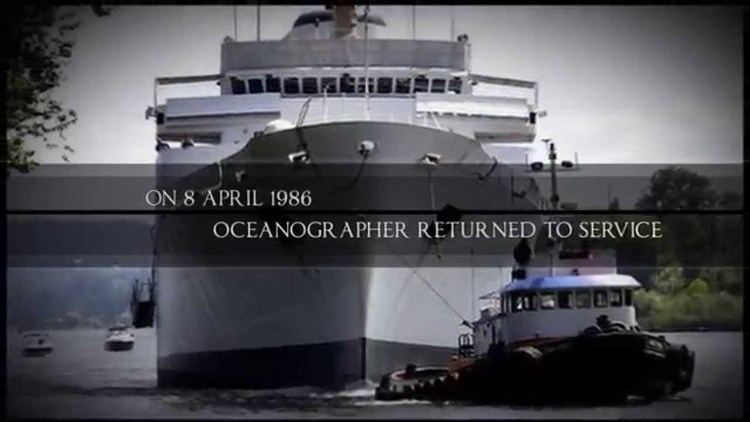Laid down 22 July 1963 Commissioned 13 July 1966 Launched 18 April 1964 Endurance 1.1 months | Completed 20 April 1966 Construction started 1964 Length 92 m Builder Jacksonville | |
 | ||
Name USC&GS Oceanographer (OSS 01) Namesake Oceanographer, a scientist who studies the ocean Fate Transferred to National Oceanic and Atmospheric Administration 3 October 1970 | ||
NOAAS Oceanographer (R 101), originally USC&GS Oceanographer (OSS O1), was an American Oceanographer-class oceanographic research vessel in service in the United States Coast and Geodetic Survey from 1966 to 1970 and in the National Oceanic and Atmospheric Administration (NOAA) from 1970 to 1996. She served as flagship of both the Coast and Geodetic Survey and NOAA fleets.
Contents
Construction
Designed by the U.S. Maritime Administration (MARAD), Oceanographer was laid down on 22 July 1963 by Gibbs Shipyards at Jacksonville, Florida, under contract to Aerojet General Shipyards and launched on 18 April 1964. Constructed under MARAD's supervision, she was completed on 20 April 1966, at 303 feet (92 meters) in length the largest vessel constructed for research purposes to date. Her stark white paint, large radome aft of the funnels, and heavy crane on the aft deck gave her a distinctive appearance. She had chemistry, wet and dry oceanographic, meteorological, gravimetric, and photographic laboratories. She also had several precision oceanographic winches.
Operational career
USC&GS Oceanographer (OSS 01) was commissioned as an "ocean survey ship" (OSS) with the U.S. Coast and Geodetic Survey at the Washington Navy Yard in Washington, D.C., on 13 July 1966 under the command of Captain Arthur L. Wardwell, USESSA. With her home port at Seattle, Washington, she was the second Coast and Geodetic Survey ship of the name, and served as flagship of the Survey's fleet. When the Coast and Geodetic Survey and other United States Government agencies combined to form NOAA on 3 October 1970, she became the research ship NOAAS Oceanographer (R 101), the first NOAA ship to bear the name, as well as flagship of the NOAA fleet.
During her 30 years of service, Oceanographer sailed over 2,000,000 nautical miles (3,700,000 km) in every major ocean. In 1967 she departed Jacksonville on 31 March on a "world science and ambassadorial cruise" in which took her from the United States East Coast to the United States West Coast via the North Atlantic Ocean, Mediterranean Sea, Red Sea, Indian Ocean, and Pacific Ocean, making many good-will stops along the way before concluding the voyage by arriving at Seattle on 11 December. In 1969 she completed the circumnavigation of the globe she began in March 1967 when she returned to the U.S. East Coast.
Other highlights of Oceanographer's career included participation in the first large-scale, coordinated international sea-air interaction survey, known as the BOMEX Study, in 1969, and environmental base-line studies on deep-ocean mining (DOMES). In 1980, Oceanographer became the first U.S. Government vessel allowed into a port of the People's Republic of China.
Oceanographer was placed in reserve in July 1981. She underwent a major refit in which she received an Alden weatherfax, a Sperry Mark 37 gyro, a Raytheon X-band Pathfinder radar, Inmarsat, an MX1102 Global Positioning System, a new salinometer, a Shipboard Environmental Acquisition System with expendable bathythermograph gear, a new meteorological station, and a Doppler current profiling system, and returned to service with this new equipment on 8 April 1986. Placed in reserve in 1989, she later returned to service again.
Final disposition
Oceanographer and NOAA Ships Discoverer (R 102) and Malcolm Baldridge (R 103), ex-Researcher, were replaced by NOAAS Ronald H. Brown under the NOAA Fleet Modernization Program in the 1990s. After being decommissioned in 1996, Oceanographer was sold to the Kirkland Yacht Club Marina of Kirkland Washington, to act as a breakwater and was renamed M/V Protector. Protector was tied up at the marina from 1997 to 2005.
In August 2005, Protector was renamed M/V Sahara and towed to a Seattle, Washington, shipyard to be refitted as a luxury cruise ship.
As of 2016, the project has been canceled and the ship is for sale for US$ 1,200,000.
